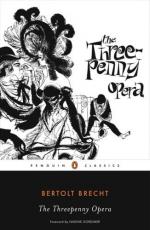|
This section contains 402 words (approx. 2 pages at 400 words per page) |

|
The Threepenny Opera Summary & Study Guide Description
The Threepenny Opera Summary & Study Guide includes comprehensive information and analysis to help you understand the book. This study guide contains the following sections:
This detailed literature summary also contains Bibliography and a Free Quiz on The Threepenny Opera by Bertolt Brecht.
Bertolt Brecht's 1928 play The Threepenny Opera was his most financially successful play and the work with which he is most closely identified. The play is an early example of his "epic theater," consisting of theatrical innovations designed to awaken audiences to social responsibility. Epic theater uses "alienating" devices, such as placards, asides to the audience, projected images, discordant music and lighting, and disconnected episodes to frustrate the viewer's expectations for simple entertainment. This "theater of illusions" (as anti-realists such as Brecht termed it) allowed the audience to comfortably and passively view a production without being changed by it. It was Brecht's intention to use drama to invoke social change, to shake his audiences out of their complacency and expect more from the theater than entertainment.
The disruptive capacity of Brecht's drama was designed to awaken the theater-goers critical mind and galvanize them into political awareness and action. The Threepenny Opera, which he produced with the aid of his secretary (and lover) Elisabeth Hauptmann (who had just translated John Gay's The Beggar's Opera [1728] into German) and composer Kurt Weill, is a satire of bourgeois society, containing many of the major elements of epic theater: placards announcing the ballad singers, discordant music, and a plot that frustrates expectations for romantic resolution. The Threepenny Opera is very closely based on Gay's eighteenth-century play, another social satire. Brecht and Hauptmann borrowed ballads from Francois Villon, and Weill turned them into darkly twisted cabaret songs for this version of the play.
Brecht also made some stylistic changes, transforming the protagonist, Macheath, into a morally ambiguous hero, emphasizing the parallels between Polly and Lucy, and creating the character of Sheriff Jackie Brown, a former army buddy of Macheath's who protects his friend's criminal activity in exchange for a percentage of his spoils. Brecht's play places blame on capitalist society for the criminal underworld that Gay presented merely as a mirror-image satire of eighteenth-century aristocracy. Weill's discordant mesh of jazz, folk, and avant-garde music adds to the play's popular appeal, which was the polar opposite of what Brecht wanted: he designed his "epic theater" to awaken the audience's critical judgement, not its empathy. Despite Brecht's designs, The Threepenny Opera has become one of the hallmarks of musical theater and his most popular play. While it is regarded in modern drama as a significant political work, it is equally revered for its unique music and darkly engaging characters.
Read more from the Study Guide
|
This section contains 402 words (approx. 2 pages at 400 words per page) |

|



